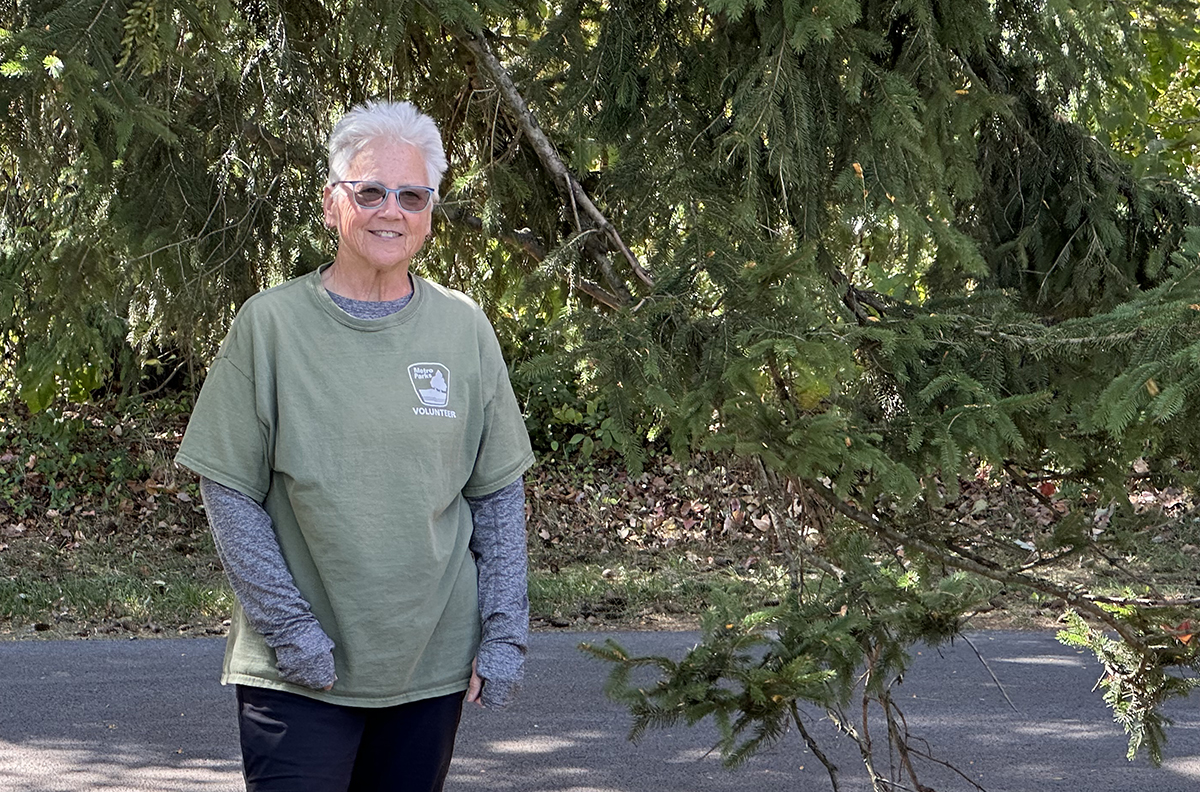
Why I volunteer at Metro Parks, what I do and what I love most about it
Volunteering has always been important to me. I retired eight years ago after working most of my career at The Ohio State University, but even while working I was very involved in helping communities through volunteer work. Back in 1997 I became a Master Gardener through Ohio State Extension. All the states have land grant universities, and each one has an organization called Extension Offices. Master Gardeners is an international program, and is part of many university extension offices. Following a course of study, Master Gardeners are charged with providing a certain number of volunteer hours each year, to provide teaching and service to communities and to coordinate community projects, all based upon factual research data.
One of the most interesting and satisfying projects I became involved with as a Master Gardener began around 2006 at a Youth Detention Center in Marysville. There were about 50 kids at the center. Many of them had been abused or had faced horrendous situations in their young lives. The center had a grassy outdoor space on site, and they had tried to grow vegetables, alas with no success. They consulted the Master Gardeners and we began working with the kids and the staff.

Kids had to earn the right to work in the gardens, by good behavior. Up to 10 kids worked in the gardens at any one time, and we structured it so that one Master Gardener would work directly with just one of the kids. We planned what the garden would become and prepared the soil for it. The project became a resounding success. We planted and harvested vegetables, and taught the kids the finer points of gardening. But our real success was in talking with the kids and becoming positive role models for them. At the start, some of the kids weren’t even aware that vegetables came from under the ground. One year, we grew sweet potatoes and a group of eight kids made sweet potato pies for the whole community of 50 kids and staff. It provided more excellent teaching opportunities, as baking is a wonderful basis for math. Baking is all about percentages, fractions and multiplying. How many eggs and how much flour will be needed to make so many pies? The kids themselves learned that math can be fun and they were tremendously proud of the pies they made and how much their pies were enjoyed by everyone. I led that particular project for about seven years, and it’s still ongoing.
I had moved to Union County shortly before I became a Master Gardener. I figured that involvement with gardening would be a great way for me to fit into my new community and so it transpired. I still volunteer as a Master Gardener and I coordinate the local chapter for Union County with another volunteer, as the county budgets were cut and it was left to volunteers to maintain its strong presence in the community.
Prior to volunteering with the Metro Parks, I was an Ohio Certified Volunteer Naturalist, and had volunteered for the Nature Conservancy. Now that I was living in Union County, and close to Glacier Ridge Metro Park, I became more familiar with the park. I became a Metro Parks volunteer in 2013, when Chrissy Hoff was the naturalist at Glacier Ridge. As well as trail roving, I helped with naturalist-led public programs, including those helping scouts with their merit badges. I’m a big hiker and backpacker and I would walk the trails at Glacier Ridge and I would pick up trash, because I hate seeing trash anywhere. I brought out a number of other Master Gardeners to do a spring ephemeral program, in which we led visitors through the woods to discover the park’s wildflowers. I continued volunteering at Glacier Ridge right up until Covid hit. For a time, all public programs stopped and there were no volunteer activities available.
Following that, I moved from Union County to Columbus and began walking at Highbanks. They have lovely hills at the park, which help me to keep fit. One day I ran into Chrissy, who had become the senior naturalist at Highbanks. She said to me, “What are you doing here?” And I more or less asked the same question back. Chrissy asked me if I would like to volunteer at Highbanks. Well, I was there at the park three or four times a week anyway, so it seemed the right thing to do.
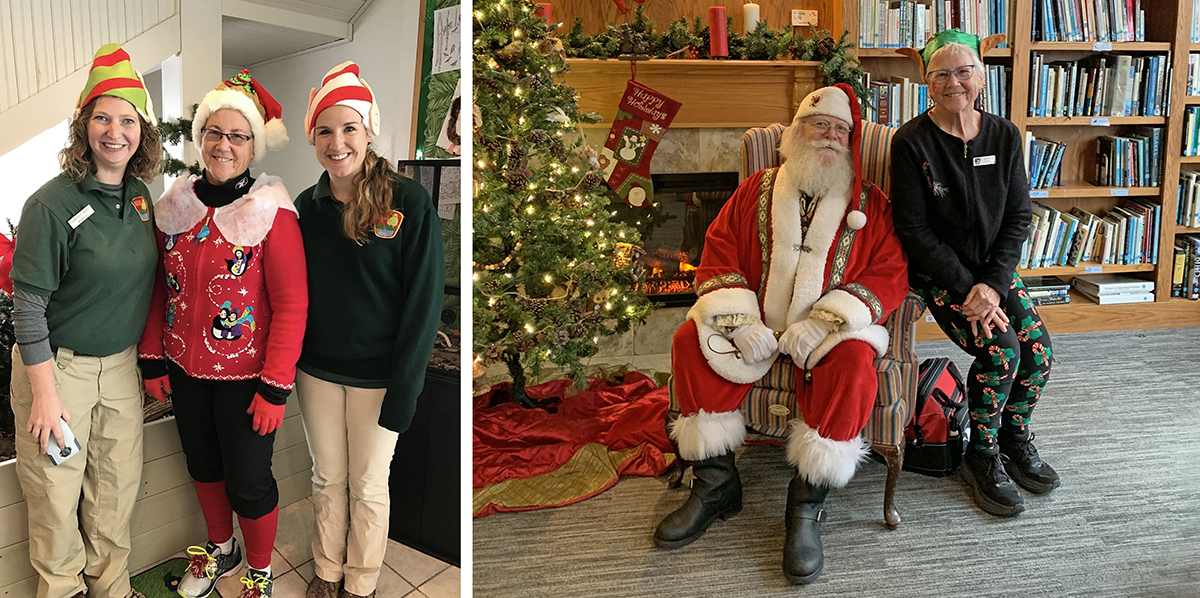
I have a goal of giving about 300 hours of volunteer time each year at Highbanks. I love trail roving and meeting and chatting with visitors. In spring and fall, I offer a backpackers’ open house program at the park. I set up in the nature center meeting room and bring in all of my equipment, including my tiny backpacking tent, with lots of easel sheets, filled with information on the most important things to know about backpacking safely. They’re informal sessions. People come in, look at the equipment and the information sheets, then ask any questions they may have about what they’ve seen or about backpacking in general
But perhaps what I love most of all about volunteering at Highbanks is my work with the park’s ambassador animals, and in particular our 2-year-old gray ratsnake, Sassafras. Before Sassafras, we had another gray ratsnake that I worked with, who was called Sneaky. Out of respect for her, I called her Miss Sneaky, because she lived to the grand old age of 23 (for a ratsnake), and gave wonderful service to our park visitors as an ambassador animal. Snakes certainly have personalities. When we first got Sassafras, she was actually called Sassy, because she didn’t like to be touched. Getting her comfortable with being touched is important, as that is the role of an ambassador animal, to interact with our public visitors.
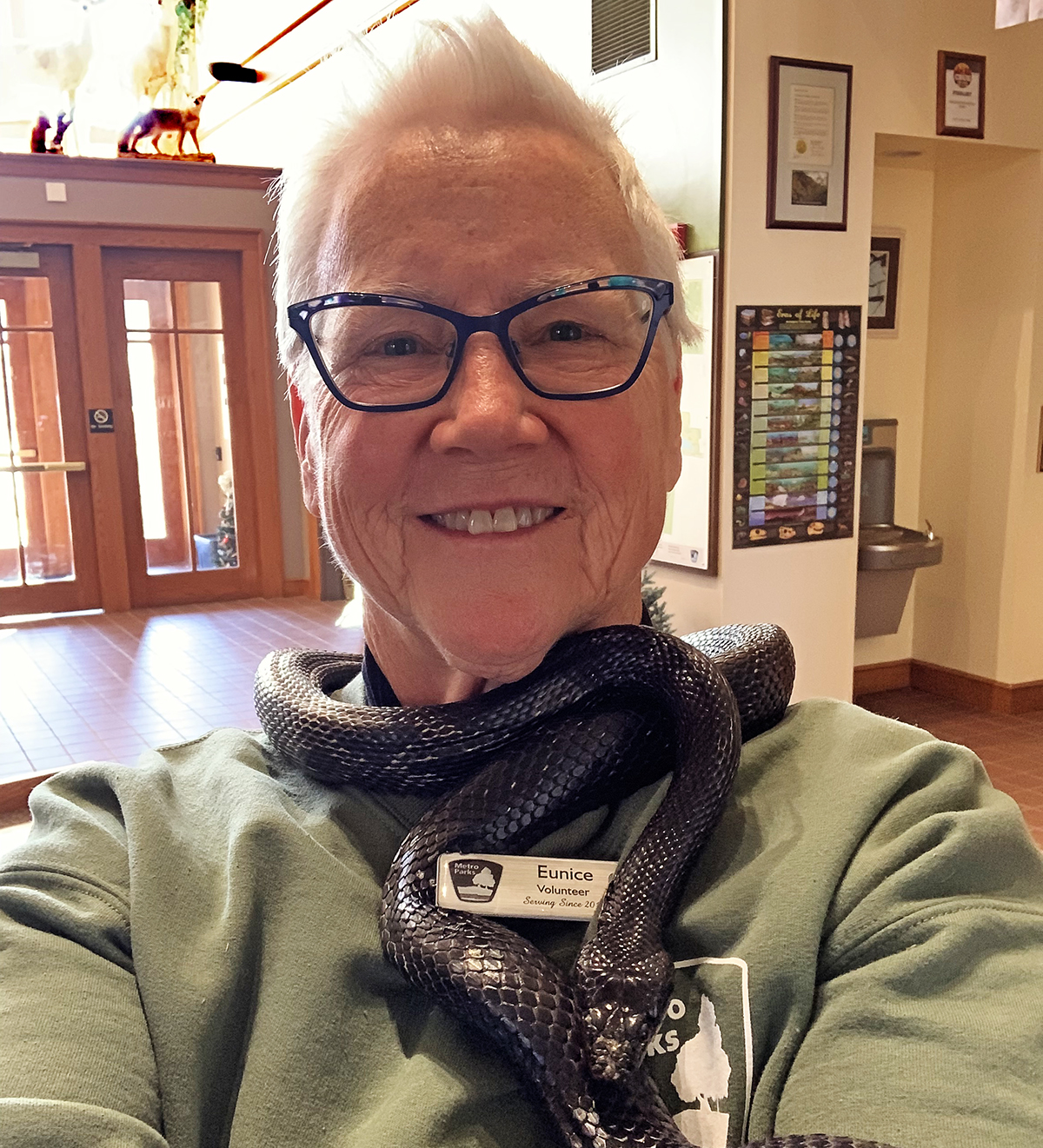
I like to rove for two or two-and-a-half hours, often from park opening at 6:30am. I often encounter people waiting to get into the park at that early hour, and even in winter, when it might be as low a temperature as 10 degrees. People just loving getting onto the park’s hilly trails. After trail roving, I usually head to the nature center, even if I don’t have a scheduled volunteer shift there. I like to spend about an hour just holding Sassafras, helping her to become comfortable with the touch of a human. We’re getting her ready to become a full-service ambassador animal. She needs the stimulation of being touched by a human, and, quite selfishly, I can say that it makes me feel very happy just holding her. I can see she is becoming much more comfortable being held, and recently, as it was warm out, I began taking her outside, to feel the sun on her body and introduce her to new stimulations. She became more active and alert, moving up and down my arm and taking obvious delight in smelling new things, such as the grass outside the nature center, and all the scents of the forest carried on the breeze. Snakes have a very strong sense of smell. They smell through receptors in their tongue, which goes in and out a lot as snakes smell their environment. That’s what Sassafras was doing when I took her out, which was a delight for both of us. Also, she made her debut as an ambassador animal this past week. We had a school visit on the Monday and the kids were invited to touch her and learn more about her species and the life of snakes. Happily she adjusted well to being touched as she begins this new and important educational role she will play for us.
I try to sign up for as many regular nature center shifts as I can, but these shifts are very popular with volunteers. At this time of year, park naturalists are very busy with school field trips, so there are more occasions when the nature center needs to be fully staffed by volunteers.
My favorite Metro Parks activity
I love to hike and backpack. I always carry my 40-pound backpack when I hike. I’ve been to all the parks and especially like the ones with hilly trails that go through the woods. As well as Highbanks, I do trail roving as a volunteer at Clear Creek, which has the park system’s most spectacular hilly trails through the woods. The other south-eastern side parks, Slate Run and Chestnut Ridge, have some great hilly trails too. A typical backpacking training hike, for me, lasts between 90 minutes and three hours, which is roughly between 3 and 7 miles. Whenever I am out backpacking or trail roving, I seem to come across other backpackers. I always stop and talk to them and ask what they are training for. All of them have a goal in mind. Recently, I have stopped and talked with two couples who are training for the Camino Française, a 500-mile hike starting in France and crossing the Pyrenees into Spain. I’ve met many people who are training to prepare for hiking the Appalachian Trail, and one couple who are training for the West Highland Way in Scotland. I’ve done the West Highland Way myself, and currently I’m preparing for the next section of my own traversal of the Appalachian Trail.
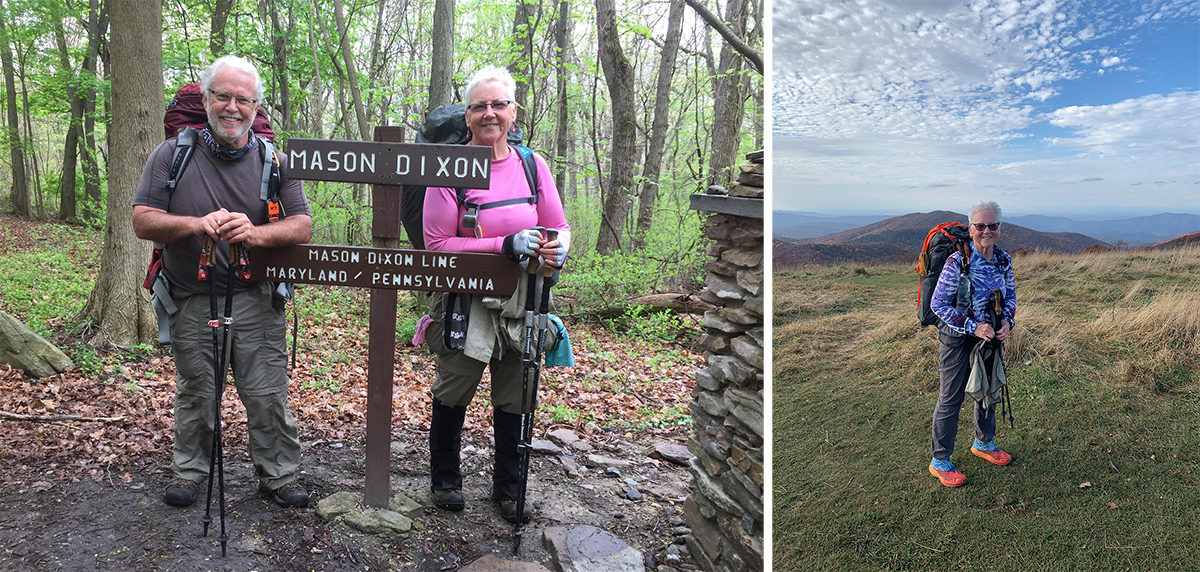
I’ll be heading out in the next couple of weeks to start a 95-mile section of the trail, which I’ll be doing over nine days. I usually do between 60 and 180 miles per visit. So far I’ve completed about 1,200 miles of the 2,300 miles overall. For my next section I’ll be starting at Duncannon in Pennsylvania, and hiking 95 miles north to a point where I can get a shuttle ride back to my car. This is an extremely rocky section of the trail, which is often referred to as Rocksylvania.
My favorite Metro Parks story that includes a positive or memorable visitor interaction
I frequently encounter an elderly gentleman on the trails at Highbanks. I believe he is 80 now, and every year he hikes the White Mountains in New Hampshire. The trails in the White Mountain National Forest are steep and rugged, and in many places require scrambling skills as well as just walking. He trains for it year-round here at Highbanks and we always have a few friendly words together. This year, he was back from his White Mountains expedition and he said to me that it had been really challenging this year, and that he was ‘starting to feel his age.’ I just looked at him in admiration and thought, ‘Goodness, I hope I can still be doing anything like what he’s doing when I turn eighty.’ As the seasons are changing here now, I also thought about the changing seasons in his own life and how he carries on doing the thing that he loves. He was so inspiring to me.
I also get inspired seeing kids brought to the parks by their parents and watching them get wet in a stream or hike on the trails, as the parents get the kids ready to understand and care for nature and our environment.
A little more about me
I was born and raised in southern California, in the hills outside the city of Riverside. I was one of six kids, five girls and one boy, and I was always outside, building forts, getting dirty, delighting in finding lizards and snakes. We were all loud and rambunctious and we played a lot outdoors. I was a girl scout, and as a family we would always take camping holidays in National Parks. We’d go camping for two or three weeks at a time. Mom would pack lunches for us and the six of us would go off early in the morning to hike, and she would wave us off and say, “See you at dinner.” There were chapels in the National Parks, and mom would take us all to church on Sunday, and we were all dirty and stinky from a full week of hiking and playing in nature.
I was probably the most independent-minded of all six of us. People told me that I was fiercely independent, just like my mom. She would always tell us girls that we needed to be independent, that we needed to work, have careers and be able to earn our own living. When I was 18 I went to California State University, Chico, which is about eight to 10 hours north of Riverside. I went up there on a bus, and asked if I could leave my footlocker at the bus station while I went off to find a place to live. I found a place to live and also my first job, to pay my way through college, within a few hours. That first job was just flipping burgers at a Jack in the Box, but it helped. It cost $100 a semester to study at Chico. How things have changed!
I left Chico with a degree in Public Administration and Economics. I went to Europe for a few months after graduating, but returned to America and began my long association with The Ohio State University. This was in 1980. I got a job there, working in Residence Halls, as an Assistant Director at Lincoln Tower, and began working on a Master’s Degree in Higher Education and Student Affairs. It’s an ideal course of study to become a university administrator, and allows us to help students to become the best versions of themselves by understanding all the various psychosocial and cognitive development processes facing students, beyond academics.
I wasn’t sure what I would find, coming to Ohio. I feared I might find it to be very conservative, but in fact I found the people in Ohio to be wonderfully kind and welcoming. Adjusting to the Ohio weather was not quite as easy. I remember going swimming one day and leaving the pool with my hair still wet. It actually froze on my head! It taught me that you have to respect the weather here. Over time, I came to love the changing seasons in Ohio. Apart from a two-year hiatus, when I worked at the University of Illinois, my entire career was spent at Ohio State. I worked in the residence halls for about 10 years, in Student Life and Housing, then moved into organizational development with departments and leadership development for faculty. I retired in 2016, when I was Director of University Policies in the Compliance Office. It was a wonderful place to work and a really good fit for me. I got to do things that made a difference in people’s lives, which is what I love to do.
I continued my own education at OSU too. I earned my PhD in Adult Education in 1996, based on research into sexual harassment. I had facilitated many revisions of OSU’s policy on sexual harassment, which inspired my much deeper research into the subject. I received the first MSL (Master’s in the Study of Law) granted by the university in 2006.
I also met my life partner, Marsha, at OSU. Marsha also worked in the residence halls when I started at OSU. We’ve been together now for more than 40 years.
Traveling – places I’ve been, places I’d love to go
I’m just back from a five-week trip to Europe. Marsha had taken a 30-week French cooking class and really wanted to go to France. We spent five days in Paris, in between the Olympics and the Paralympics, and moved on from there to Lyon, to visit one of the most famous restaurants in the world. It’s named simply as Paul Bocuse, after its founder, with an alternative name of L’Auberge du Pont de Collonges, meaning the Inn on the Bridge at Collonges (which is a commune or suburb of Lyon). It was the highlight of our trip for Marsha.
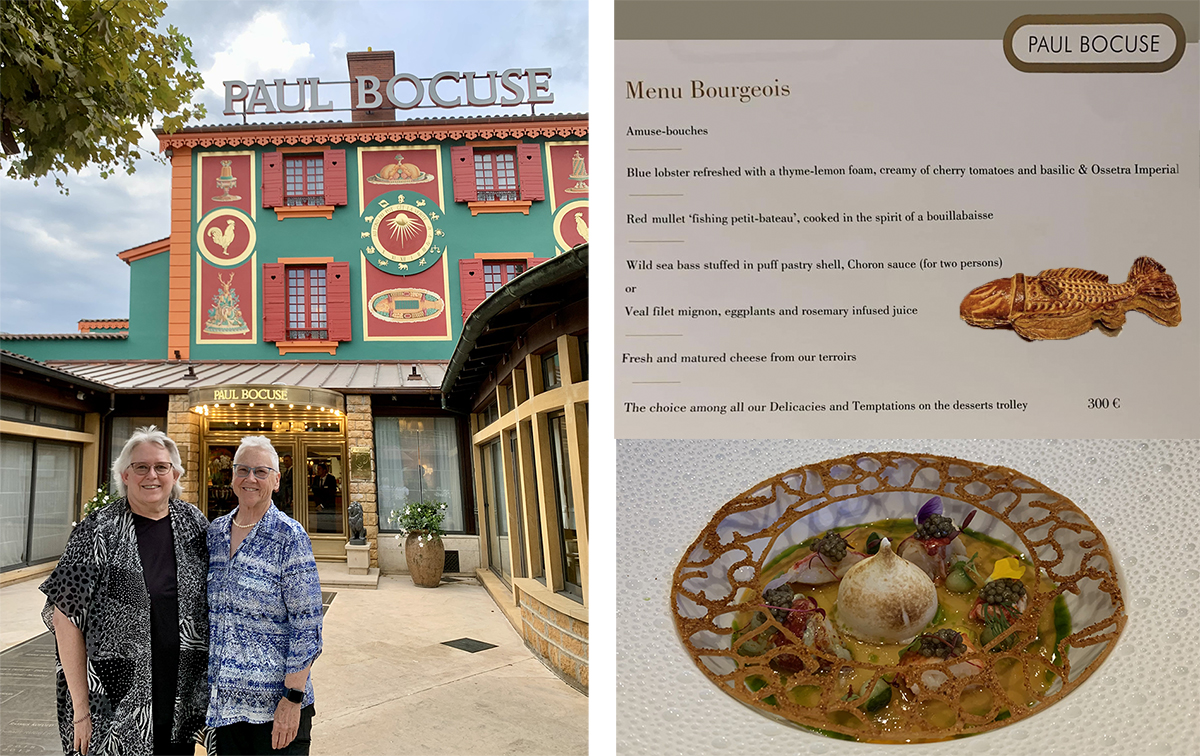
Paul Bocuse was known as the pope of gastronomy and was one of the founders of Nouvelle cuisine, a very healthy and delicious cooking style. Although Monsieur Paul, as he was known affectionately, passed away in 2018, he is immortalized not just through his cuisine and restaurant, but as the inspiration behind the chef in the world-wide-hit animated film, Ratatouille. We don’t have a “bucket list,” but if we did, the culinary experience at the Paul Bocuse Restaurant would qualify. The service, the china, the silverware, the atmosphere, the food… all of it was exquisite. Our three-hour meal was spectacular from start to finish and was truly a meal of a lifetime. From Lyon we took a river boat cruise, booked with Olivia Travel, an all women travel group, through Provence and Aix-En-Provence, ending just outside Marseille.
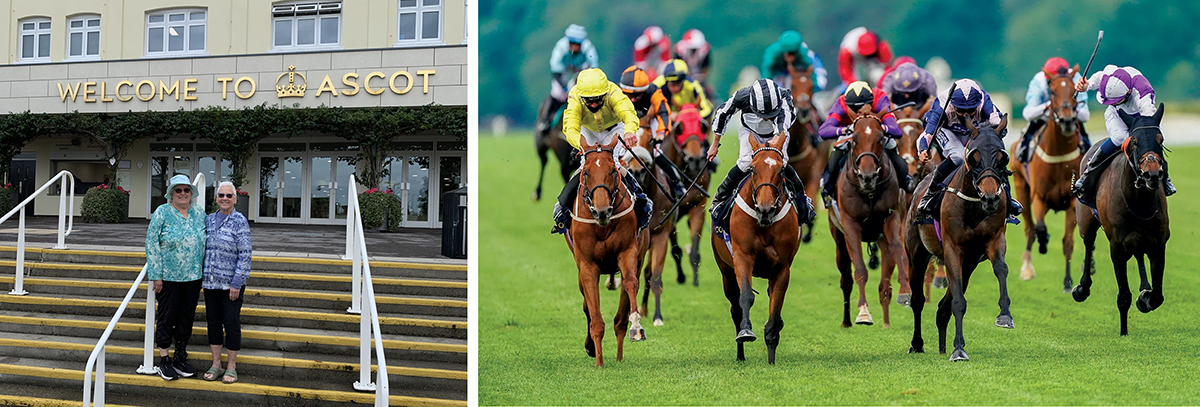
We also spent four days in London, and we went to watch horse racing from the King’s Enclosure at Ascot. This was another highlight of the trip for Marsha, as she had read all the Dick Francis novels, with characters good and ill from the world of horse racing. We visited the spectacular and ancient Stonehenge, and then spent some time relaxing in the Cotswolds, in Winchcombe, known as the walker’s town. We also visited Highgrove House and Gardens, which is the private residence of King Charles and Queen Camilla, in Gloucestershire. I had read a lot about Highgrove and other gardens in Europe, and knew a lot about the king’s work and concern for the environment. I was thrilled to see the Highgrove Gardens, a typically beautiful English Garden filled with tons of native plants. Unfortunately no photography was allowed there, but the 90-minute public tour of the gardens was well worth it.
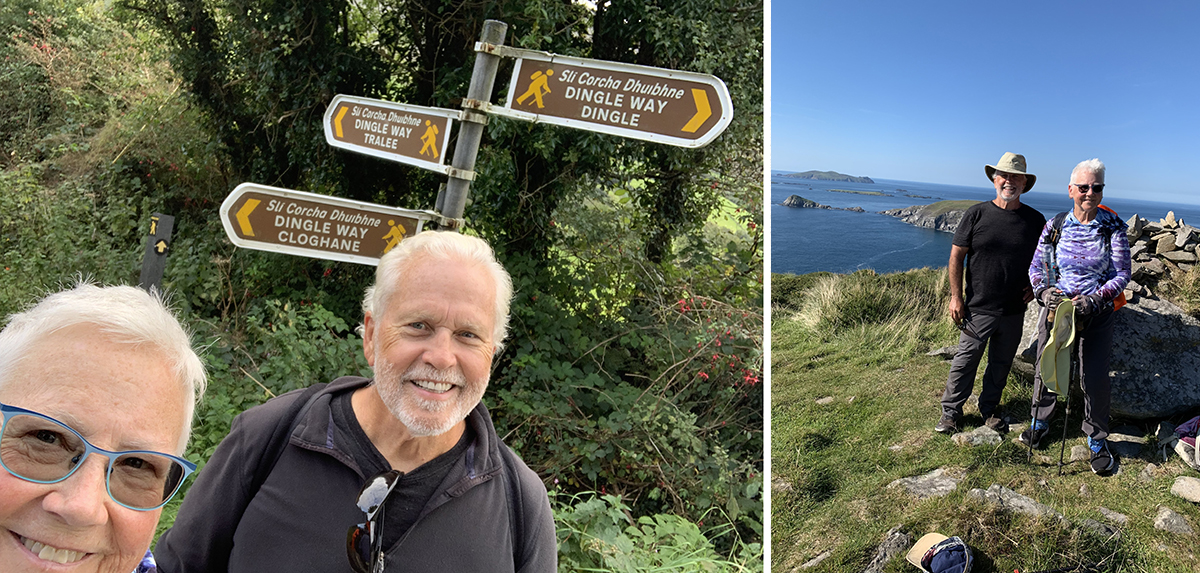
Marsha went home from England, but I had an extra stage to the vacation. I met up with a friend of mine, Dan, who flew to Ireland to meet me so we could walk the Dingle Way. It’s a 110-mile hike which we completed over eight days. I honestly believe that the best way to see a country is to walk it. The Dingle Way loops around the Dingle Peninsula, which is the most westerly point in the whole of Europe with spectacular beaches and cliffs at almost every turn. A few years ago, Dan and I had walked the West Highland Way together in Scotland, which is about a hundred miles with its own marvelous coastline scenery.
A trip on my list of things to do is the Camino Norte, which is a 500-mile walk along the northern coast of Spain. Typically it takes five weeks to complete and I would love to do it while I’m still able to maintain that level of activity. I’ve been to Spain before and for some reason I feel especially comfortable there, with the language, culture and people. I understand a little Spanish, and can speak enough to order café con leche and lunch!
Fun facts about me and my family
1. Reunion dinners! I’m no great chef, but I do love to organize reunion dinners where Marsha makes foods from the countries I’ve visited with friends and fellow hikers. In Ireland, I enjoyed the best fish chowder ever, very similar to a Scottish dish, called Cullen Skink, and also called a smoked haddock chowder. It’s made of smoked haddock, potatoes and onions. After a previous Scottish trip, I was able to get a couple of tins of haggis and some black sausage, from Jungle Jim’s in Cincinnati. It was on that Scottish trip that I discovered how much I liked mussels. I always thought they were gross, but cooked slowly in a white wine sauce, and with delicious homemade bread to use for dipping, I found it an absolute delight, and especially so after a 10- to 15-mile hike.
2. Tailgating! I love to tailgate, but I don’t like football. I have season tickets to all the OSU football games, but I’m strictly there to tailgate. If it’s a noon game, I’ll set up my pitch outside the stadium at 6am, or 8am for a three-thirty kick-off. I take my car down there the night before, and have my camp stove all set up and ready to go to make egg sandwiches, or bratwurst and hamburgers with baked beans. Marsha and friends then go off to watch the game and I have the pleasure of going home after a great few hours of camaraderie and good eats with friends.
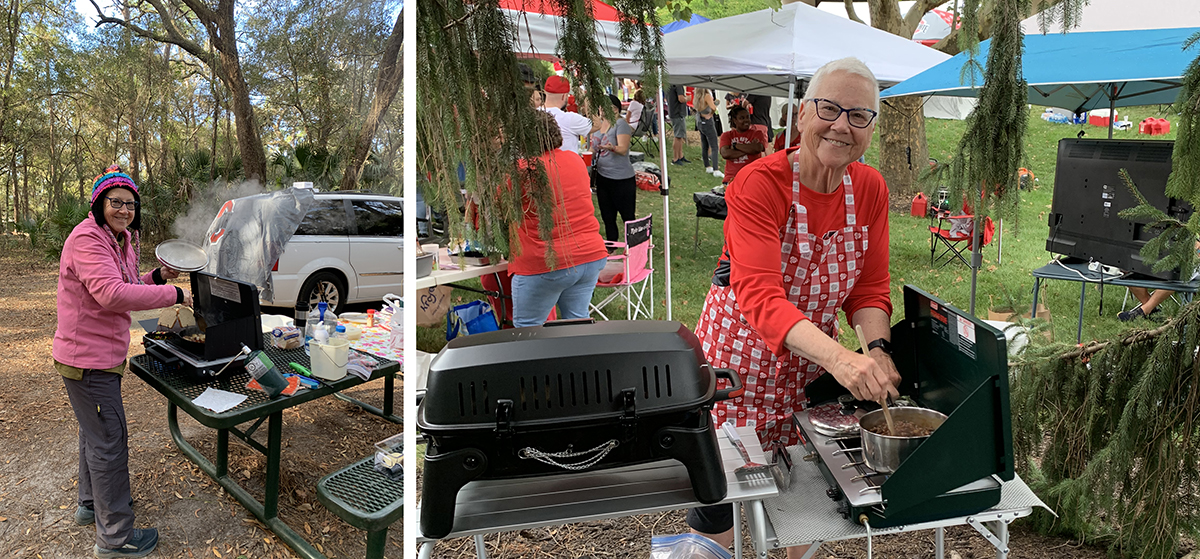
3. No kids, but lots of grandnieces and grandnephews! We have a coterie of grandnieces and grandnephews that live near to us, five girls and five boys. As we get older, it’s great to have younger people in the family. They help keep us young. We’re off tomorrow to watch one of our grandnieces play soccer in Chillicothe. No tailgating, unfortunately, but it will still be a lot of fun.
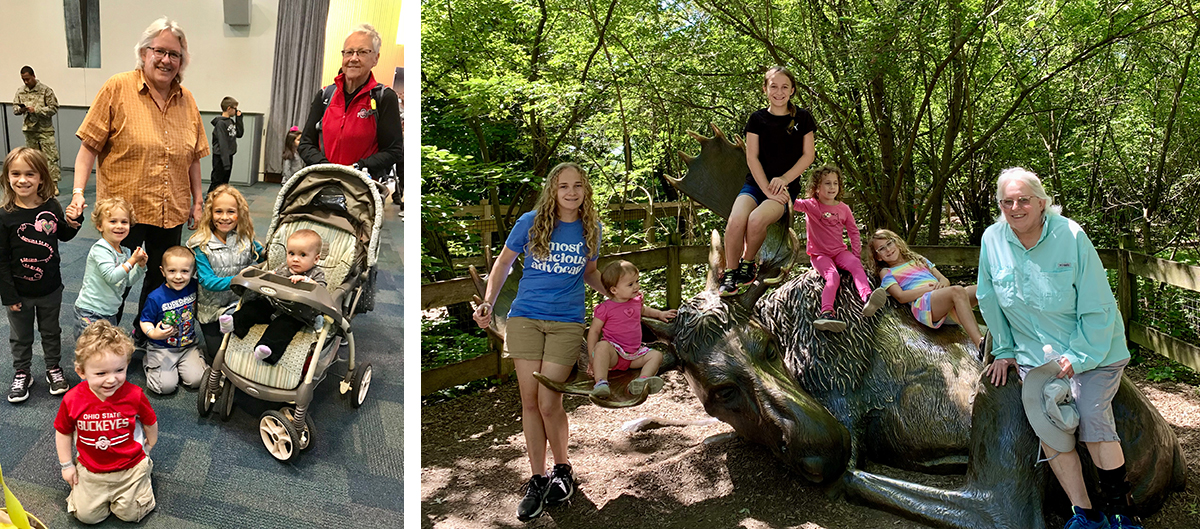

My favorite food and dessert
I like to eat, and Marsha is a fabulous cook. I love her salads, when she uses the shaved leaves of brussels sprouts as the greenery, with dried fruits and nuts and lots of homemade dressings. On my trip to Ireland I discovered that beetroot and goat’s cheese salad was very common in the various pubs and inns. Marsha makes it taste just like it did in Ireland, using the bitter greens from the beets, and the fleshy root, along with goat’s cheese, nuts, onions, dried apricots and raisins, plus cherry tomatoes and a dash of balsamic vinegar. Absolutely delicious. And she also makes fantastic fish chowder, which I had come to love after experiencing it in Ireland and Scotland.
My favorite entertainment
I’m not one for watching TV or movies, and I read less, now, than I used to. My overarching form of entertainment is to be out on the hills and in the forest with my backpack on. For overnight backpacking sessions, I like to read a chapter or two of young adult fantasy, which is a fun and not overly taxing read before going to sleep. I want to be able to keep on backpacking for as long as I can, which is why I work regularly with a personal trainer. I have a one-hour session per week with her and she works hard to help with my balance challenges and work on my core strength and stability. She knows what challenges I face and how I can best overcome them. I’m so thankful that I can still hike and backpack.
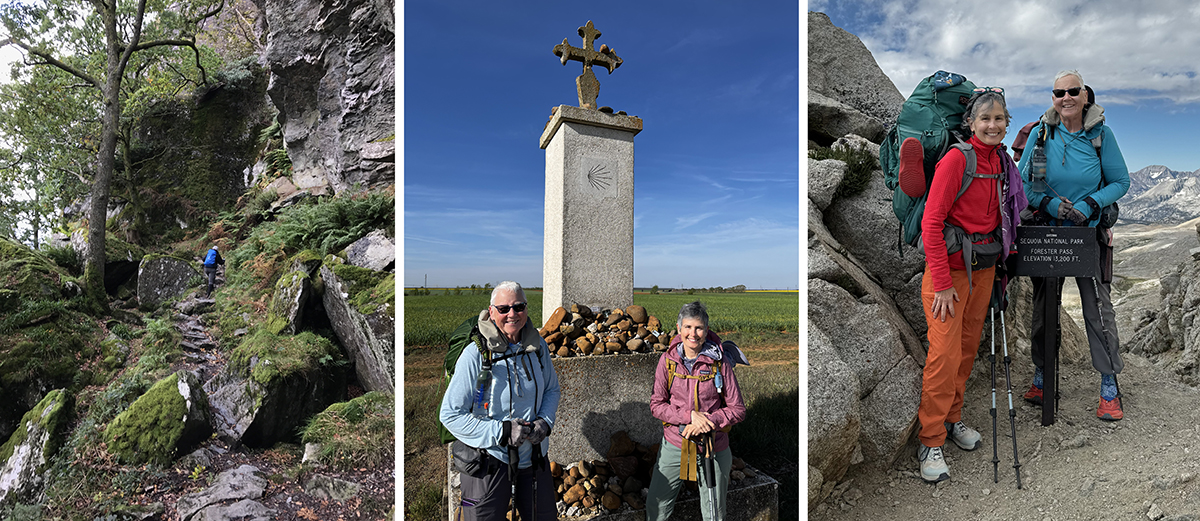
A related entertainment, for me, is planning for future backpacking treks and tracking my previous hikes. I love to make spreadsheets filled with data about the places I’ve been and the things I’ve seen there. I’ve been told I’m obsessive about it, which is probably true, but I find it a very peaceful and profitable use of my time. It both stimulates memories and allows me to look ahead with relish to future hikes.
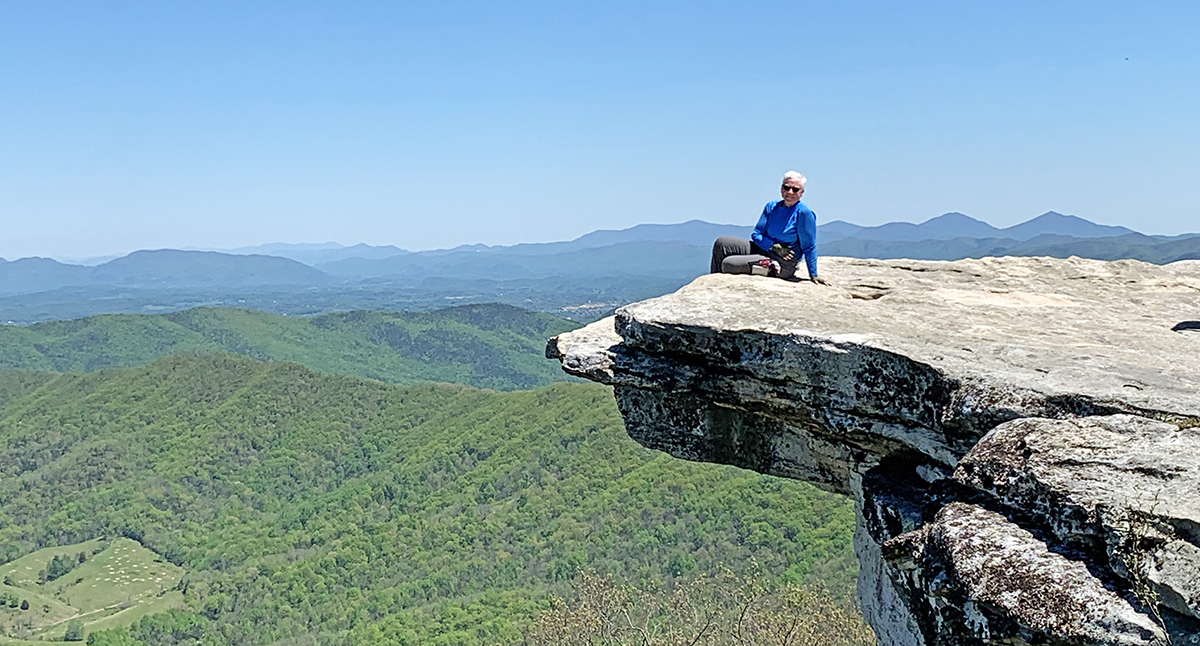
Eunice Hornsby was talking to Communications Coordinator, Virginia Gordon
What Highbanks Naturalist Claire Whillans says about Eunice
“Eunice is a stellar volunteer here at Highbanks. She brings her energetic nature and generous spirit to everything she does at the park, whether that be trail roving, offering to clean the nature center, providing park staff with an endless supply of snacks and candies, or interpreting with our beloved snake, ‘Sassy’ for park visitors. In 2023 alone, Eunice dedicated 330 hours of volunteer service to the park. We’re so happy to have her on the Highbanks team!”

Thank you, thank you, thank you!! Metro Parks and our visitors are blessed to have volunteers with such amazing career and life experience!
We were involved with the Master Gardeners. I went off to work with dogs and lost touch. So good to hear all you are doing and involved with. And that we’re both involved with nature again, you with the park and me with the Franklin County Pollinator Pathways.
Wow….what a joyous life story and descriptive writing. I have done many hikes but wished I had more time left and better knees to do what you have accomplished. Thanks for sharing your story. I will have more respect for snakes now too.
Eunice,
You are an amazing person! It was a joy to read all about you. I am so impressed by your love of life and experiencing it to the fullest. I am sure you are an inspiration to many people; you are inspiring me to think about volunteering with Metro Parks down the road. Thank you for all that you have done and continue to do, both with the parks as well as with your Master Gardner skill set. I hope you are able to complete the hikes you mentioned. The world needs more people like you.
Karen Irvine
I thoroughly enjoyed reading your story, Eunice! Thank you for your service to our beautiful metro parks. I particularly enjoyed the picture of you and Miss Sneaky!